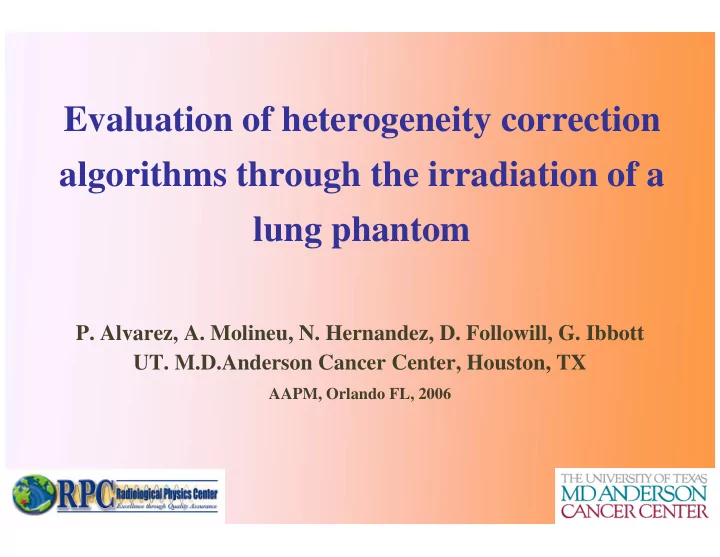

Evaluation of heterogeneity correction algorithms through the irradiation of a lung phantom P. Alvarez, A. Molineu, N. Hernandez, D. Followill, G. Ibbott UT. M.D.Anderson Cancer Center, Houston, TX AAPM, Orlando FL, 2006
RPC Lung phantom Tumor (TLD) Heart Cord S Lung Lung LL Include A • different structures Water fillable plastic shell • imaging and dosimetry insert
RPC Phantom Tumor dimension Tumor (TLD) Film Slits Ovoid shape 3 cm diameter 5cm long Densities Lung = 0.33g/cm 3 Heart, cord = 1.1 g/cm 3 Cord = 1.31 g/cm3 Disassembled Lung Insert Tumor = 1.04 g/cm 3 Dosimeters TLD and Gafchromic film
Prescription • Based on RTOG 0236 (SBRT Radioablation study) - Energies: 4 – 10 MV - ≥ 7 non-opposing static fields or ≥ 340° arc rotation technique. - SBRT technique. - 20 Gy/fx to 95% of the PTV - Homogeneous planning and calculation of M.U. - Must submit heterogeneous plan based on homogeneous M.U. set
Phantom Results • A total of 21 irradiations were analyzed • The 6 MV photon beam was used most often • The TPS used to plan the cases were: Pinnacle, BrainLab, XiO, Precise, Eclipse, Ergo and RenderPlan. • Convolution Superposition algorithm was used most often.
Phantom Results Center of Tumor TPS TPS Dose Calc. Algorithm # irradiations D hetero /D homo 1.19 ± 2.6% Precise Scatter Int. Clarkson 2 1.21 ± 0.1% BrainLab Clarkson & Pencil beam 4 1.19 ± 4.6% Eclipse Pencil Beam 2 1.19 ± 0.1% Ergo 3D Convol. Pencil Beam 1 Clearly, there are RenderPlan Change in primary attenuation 1 1.20 two groupings 1.13 ± 2.1% Pinnacle Adaptive convolve 8 1.12 ± 2.4% XiO Superposition/Convolution 3
Phantom Results (cont’d) Center of Tumor Measured TPS Dose Calc. Algorithm # irradiation D TLD /D hetero 0.99 ± 3.1% Precise Scatter Int. Clarkson 2 0.96 ± 2.7% BrainLab Clarkson & Pencil beam 4 0.97 ± 1.6% Eclipse Pencil Beam 2 0.98 ± 3.2% Ergo 3D Convol. Pencil Beam 1 Change in primary RenderPlan attenuation 1 0.92 0.99 ± 2.3% Pinnacle Adaptive convolve 8 XiO Superposition/Convolution 1 0.96
PTV Periphery and Lung Points PTV = Tumor (CTV) + 0.5 cm in axial plane + 1 cm in longitudinal plane. Lung constraint: points 2 cm from the PTV X PTV Periphery points CTV X X CTV X X X Lung Axial Plane points Longitudinal Plane
Profile analysis Right Left Profile Convolution Superposition example 30 Left Right 20 Prescribed D Dose (Gy) D 2cm 10 PTV 0 -7 -6 -5 -4 -3 -2 -1 0 1 2 3 4 5 6 7 Distance (cm) RPC Film Institution off Institution on
Profile analysis Right Left Profile Clarkson example 30 Left Right 20 Prescribed D Dose (Gy) D 2cm 10 PTV 0 -7 -6 -5 -4 -3 -2 -1 0 1 2 3 4 5 6 7 Distance (cm) RPC Film Institution off Institution on
Phantom Results (PTV Periphery) TPS D hetero/ D homo TPS Dose Calc. Algorithm # irradiation 1.21 ± 2.7% Precise Scatter Int. Clarkson 2 1.26 ± 3.5% BrainLab Clarkson & Pencil beam 1 1.18 ± 4.0% Eclipse Pencil Beam 2 1.19 ± 1.8% Ergo 3D Convol. Pencil Beam 2 1.04 ± 6.1% Pinnacle Adaptive convolve 8 1.11 ± 6.4% XiO Superposition/Convol. 2 Two separate groupings again
Phantom Results (Lung points) TPS D hetero/ D homo TPS Dose Calc. Algorithm # irradiation Axial plane 1.19 ± 4.2% Precise Scatter Int. Clarkson 2 1.23 ± 5.7% BrainLab Clarkson & Pencil beam 1 1.18 ± 11.2% Eclipse Pencil Beam 2 1.20 ± 5.3% Ergo 3D Convol. Pencil Beam 2 1.12 ± 6.0% Pinnacle Adaptive convolve 8 1.14 ± 6.5% XiO Superposition/Convol. 2 Two separate groupings again
Phantom Results (PTV Periphery) Measurements PTV Periphery measured D film/ D hetero TPS Dose Calc. Algorithm # irradiation Precise Scatter Int. Clarkson 2 0.88 BrainLab Clarkson & Pencil beam 1 0.79 Eclipse Pencil Beam 2 0.92 Ergo 3D Convol. Pencil Beam 2 0.84 Pinnacle Adaptive convolve 8 0.98 XiO Superposition/Convol. 1 0.96 Two separate groupings again
Conclusions • The average tumor TLD/Inst ratio is 0.97 (range 0.92 to 0.99). Good agreement for Convolution Superposition algorithms in the tumor. • Large differences exists between the Convolution Superposition heterogeneity corrected dose calculations and other algorithms (ratios of 1.13 vs. 1.20). • Heterogeneity corrected doses at the PTV periphery and lung points are higher than uncorrected doses. • The Convolution Superposition algorithm calculations agree with the RPC measurements.
Thank you
Recommend
More recommend